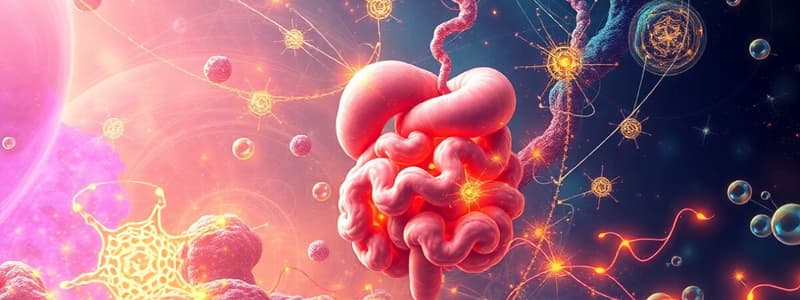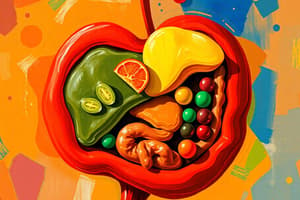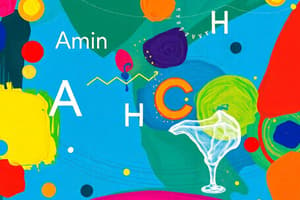Podcast
Questions and Answers
What condition is characterized by high concentrations of cystine in urine due to a transport error?
What condition is characterized by high concentrations of cystine in urine due to a transport error?
- Steatorrhea
- Cystic fibrosis
- Cystinuria (correct)
- Chronic pancreatitis
Steatorrhea is caused by the incomplete digestion and absorption of sugars.
Steatorrhea is caused by the incomplete digestion and absorption of sugars.
False (B)
What are the major enzyme systems responsible for degrading damaged or unneeded proteins?
What are the major enzyme systems responsible for degrading damaged or unneeded proteins?
The ATP-dependent ubiquitin-proteasome system and the ATP-independent degradative enzyme system of the lysosome.
Cystinuria is a type of __________.
Cystinuria is a type of __________.
Match the following conditions with their descriptions:
Match the following conditions with their descriptions:
How are free amino acids transported into cells?
How are free amino acids transported into cells?
The small intestine is involved in a common transport system for amino acids.
The small intestine is involved in a common transport system for amino acids.
What does the term 'amino acid pool' refer to?
What does the term 'amino acid pool' refer to?
Proteins that are selected for degradation by the ubiquitin-proteasome pathway are tagged with __________.
Proteins that are selected for degradation by the ubiquitin-proteasome pathway are tagged with __________.
What is a common result of a deficiency in pancreatic secretion?
What is a common result of a deficiency in pancreatic secretion?
Which process requires energy in the form of ATP for protein degradation?
Which process requires energy in the form of ATP for protein degradation?
Proteins with aspartate at the N-terminal have a long half-life.
Proteins with aspartate at the N-terminal have a long half-life.
Name one source of amino acids that contributes to the amino acid pool.
Name one source of amino acids that contributes to the amino acid pool.
The ____ primarily degrades extracellular proteins, such as plasma proteins.
The ____ primarily degrades extracellular proteins, such as plasma proteins.
Match the following N-terminal residues with their respective half-lives:
Match the following N-terminal residues with their respective half-lives:
What is the composition of the amino acid pool in the human body?
What is the composition of the amino acid pool in the human body?
The amino acid pool is constantly changing during nitrogen balance.
The amino acid pool is constantly changing during nitrogen balance.
What happens to amino acids when they are converted to glucose?
What happens to amino acids when they are converted to glucose?
Proteins that are rich in sequences of proline, glutamate, serine, and threonine are ____ degraded.
Proteins that are rich in sequences of proline, glutamate, serine, and threonine are ____ degraded.
Which factor influences the half-life of a protein?
Which factor influences the half-life of a protein?
What condition is characterized by the abnormal appearance of lipids in feces due to incomplete digestion and absorption of fats and proteins?
What condition is characterized by the abnormal appearance of lipids in feces due to incomplete digestion and absorption of fats and proteins?
Cystinuria is an autosomal dominant disease related to amino acid transport errors.
Cystinuria is an autosomal dominant disease related to amino acid transport errors.
Name the system responsible for protein degradation that is ATP-independent.
Name the system responsible for protein degradation that is ATP-independent.
Proteins that are tagged for degradation in the cytosol are covalently attached to __________.
Proteins that are tagged for degradation in the cytosol are covalently attached to __________.
Match the following conditions with their descriptions:
Match the following conditions with their descriptions:
Which of the following amino acids is part of the transport error in cystinuria?
Which of the following amino acids is part of the transport error in cystinuria?
What is the primary role of the proteasome?
What is the primary role of the proteasome?
Active transport of free amino acids into cells requires the hydrolysis of ATP.
Active transport of free amino acids into cells requires the hydrolysis of ATP.
The proteasome requires ATP for the degradation of proteins.
The proteasome requires ATP for the degradation of proteins.
What term describes the pool of free amino acids available in the human body?
What term describes the pool of free amino acids available in the human body?
What influences the half-life of a protein?
What influences the half-life of a protein?
The __________-dependent system is responsible for recognizing and degrading ubiquitin-tagged proteins.
The __________-dependent system is responsible for recognizing and degrading ubiquitin-tagged proteins.
Proteins with ______ as the N-terminal amino acid have a very short half-life of about 3 minutes.
Proteins with ______ as the N-terminal amino acid have a very short half-life of about 3 minutes.
Match the following protein degradation systems with their primary functions:
Match the following protein degradation systems with their primary functions:
What is a potential result of a deficiency in pancreatic secretion?
What is a potential result of a deficiency in pancreatic secretion?
What is a source of amino acids in the amino acid pool?
What is a source of amino acids in the amino acid pool?
The amino acid pool is depleted only by the synthesis of body proteins.
The amino acid pool is depleted only by the synthesis of body proteins.
What is meant by 'nitrogen balance' in an individual?
What is meant by 'nitrogen balance' in an individual?
The lysosome primarily degrades ______ proteins.
The lysosome primarily degrades ______ proteins.
Match the types of inputs to the amino acid pool with their descriptions:
Match the types of inputs to the amino acid pool with their descriptions:
Study Notes
Abnormalities in Protein Digestion
- Individuals with a deficiency in pancreatic secretion, due to conditions like chronic pancreatitis, cystic fibrosis, or surgical removal of the pancreas, experience incomplete digestion and absorption of fats and proteins.
- This results in an abnormal appearance of lipids in feces, known as steatorrhea, and undigested protein in the feces.
Transport of Amino Acids into Cells
- Absorbed amino acids are either metabolized by the liver or released into the general circulation.
- Free amino acids are transported from the extracellular fluid to the cell by active transport, requiring the hydrolysis of ATP.
- At least seven distinct transport systems exist for different amino acids.
- The small intestine and proximal tubule of the kidney share a common transport system for amino acids.
Cystinuria
- Cystinuria is an inherited autosomal recessive disease characterized by a defect in the transport and reabsorption of amino acids lysine, ornithine, arginine, and cystine.
- High concentrations of cystine in the urine lead to the formation of cystine stones (calculi) in the kidneys, ureters, and bladder.
- This condition is a type of aminoaciduria.
- Cystine, not cysteine, is involved; cystine is a dimer of cysteine.
Degradation of Body Proteins
- Two major enzyme systems are responsible for degrading damaged or unneeded proteins: the ATP-dependent ubiquitin-proteasome system of the cytosol and the ATP-independent degradative enzyme system of the lysosome.
Ubiquitin-Proteasome Proteolytic Pathway
- Ubiquitin is a small, globular, non-enzymatic protein.
- Proteins targeted for degradation by this pathway are first covalently attached to ubiquitin through the amino acid lysine.
- Ubiquitin-tagged proteins are recognized by a large, barrel-shaped, macromolecular, proteolytic complex called a proteasome.
- Proteasomes function like a garbage disposal, primarily degrading endogenous proteins synthesized within the cell.
- The proteasome unfolds, deubiquitinates, and cuts the target protein into fragments, which are further degraded into amino acids that enter the amino acid pool.
- This process requires energy in the form of ATP.
The ATP-Independent Degradative Enzyme System of the Lysosome
- Lysosomal enzymes (acid hydrolases) primarily degrade extracellular proteins, such as plasma proteins taken into the cell by endocytosis and cell-surface membrane proteins utilized in receptor-mediated endocytosis.
Chemical Signals for Protein Degradation
- Proteins have diverse half-lives.
- The half-life of a protein is influenced by the nature of the N-terminal residue.
- Proteins with serine as the N-terminal amino acid are long-lived, with a half-life over 20 hours.
- Conversely, proteins with aspartate as the N-terminal amino acid have a half-life of only 3 minutes.
- Additionally, proteins rich in sequences containing proline, glutamate, serine, and threonine are rapidly degraded.
Amino Acid Pool
- The amino acid pool refers to the free amino acids present throughout the body, including cells, blood, and extracellular fluids.
- This pool typically contains approximately 90-100 grams of amino acids.
- It is supplied by three sources: amino acids from the degradation of body proteins, amino acids derived from dietary protein, and the synthesis of nonessential amino acids from simple metabolic intermediates.
Amino Acid Pool Depletion
- The amino acid pool is depleted by three routes: synthesis of body protein, utilization of amino acids as precursors of essential nitrogen-containing small molecules, and conversion of amino acids to glucose, glycogen, fatty acids, ketone bodies, or CO2 + H2O.
Nitrogen Balance
- In healthy, well-fed individuals, the input to the amino acid pool is balanced by the output, resulting in a constant amount of amino acids in the pool.
- This state is referred to as a steady state, and the individual is said to be in nitrogen balance.
Protein Digestion and Absorption Abnormalities
- Individuals with pancreatic insufficiency, caused by conditions such as chronic pancreatitis, cystic fibrosis or surgical removal of the pancreas, experience incomplete digestion and absorption of fats and proteins.
- This results in steatorrhea (abnormal appearance of lipids in feces) and undigested proteins in the feces.
Amino Acid Transport
- Absorbed amino acids are either metabolized by the liver or released into the general circulation.
- Free amino acids are transported from extracellular fluid into cells via active transport, requiring ATP hydrolysis.
- At least seven different transport systems exist for various amino acids.
- The small intestine and proximal tubule of the kidney share a common transport system for amino acids.
Cystinuria: An Inherited Transport Defect
- Cystinuria is an inherited autosomal recessive disorder characterized by an error in transport and reabsorption of the amino acids lysine, ornithine, arginine, and cystine.
- This leads to high concentrations of cystine in the urine, resulting in the formation of cystine stones (calculi) in the kidneys, ureters, and bladder.
- The disease affects the transport of cystine, a dimer of cysteine.
Protein Degradation: Two Major Systems
- Two primary enzyme systems are responsible for degrading damaged or unneeded proteins:
- The ATP-dependent ubiquitin-proteasome system in the cytosol.
- The ATP-independent degradative enzyme system within lysosomes.
Ubiquitin-Proteasome Proteolytic Pathway
- Ubiquitin, a small globular non-enzymatic protein, tags unwanted proteins for degradation.
- Proteins tagged with ubiquitin are recognized by proteasomes, large barrel-shaped macromolecular complexes that function like garbage disposals.
- Proteasomes primarily degrade endogenous proteins, proteins synthesized within the cell.
- The proteasome unfolds, deubiquitinates, and cuts the target protein into fragments that are then further degraded into amino acids, which enter the amino acid pool.
- This selective degradation of proteins by the ubiquitin-proteasome complex requires energy in the form of ATP.
Lysosomal Degradation System
- Lysosomal enzymes (acid hydrolases) primarily degrade extracellular proteins, including:
- Plasma proteins taken into the cell by endocytosis.
- Cell-surface membrane proteins used in receptor-mediated endocytosis.
Chemical Signals for Protein Degradation
- Proteins have varying half-lives, influenced by the N-terminal amino acid.
- Proteins with serine as the N-terminal amino acid are long-lived, having a half-life of over 20 hours.
- Conversely, proteins with aspartate as the N-terminal amino acid have a short half-life of only 3 minutes.
- Proteins rich in sequences containing proline, glutamate, serine, and threonine are rapidly degraded.
Amino Acid Pool
- This pool refers to the free amino acids present throughout the body, found in cells, blood, and extracellular fluids.
- It comprises approximately 90-100 grams of amino acids.
- The amino acid pool is supplied by three sources:
- Amino acids from the degradation of body proteins.
- Dietary protein-derived amino acids.
- Synthesis of nonessential amino acids from simple metabolic intermediates.
Amino Acid Pool Dynamics
- The amino acid pool is depleted through three routes:
- Synthesis of body proteins.
- Utilization of amino acids as precursors for essential nitrogen-containing small molecules.
- Conversion of amino acids into glucose, glycogen, fatty acids, ketone bodies, or CO2 + H2O.
Nitrogen Balance
- In healthy, well-fed individuals, the input and output of amino acids in the pool are balanced, maintaining a constant amount.
- This state is considered nitrogen balance, where the amino acid pool is in steady state.
Studying That Suits You
Use AI to generate personalized quizzes and flashcards to suit your learning preferences.
Related Documents
Description
Explore the mechanisms of protein digestion and the transport of amino acids into cells. This quiz covers conditions impacting pancreatic secretion, such as cystic fibrosis and chronic pancreatitis, as well as the inheritance pattern of cystinuria. Test your knowledge on these biochemical processes and their implications on health.



